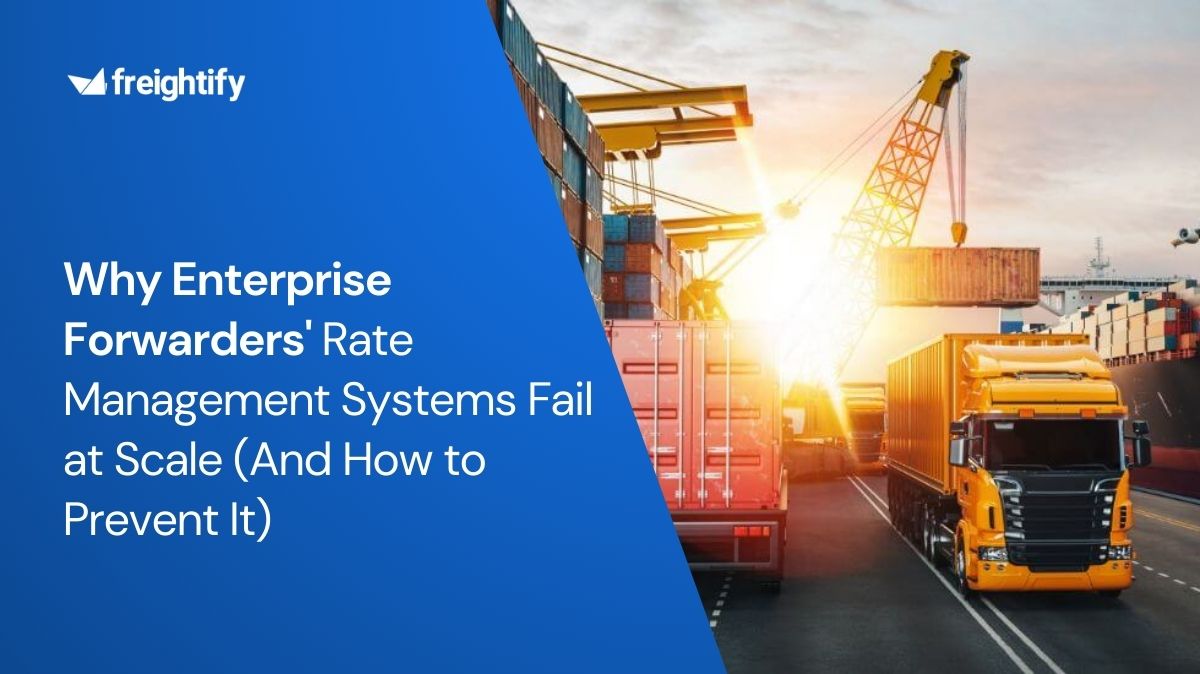The digital freight forwarding market has taken the world by storm. Since the onset of the pandemic, the supply chain imbalance has left consignors in the lurk allowing shippers to capitalize on the global economic position.
In an uneven demand and supply situation, the role of a freight forwarder becomes heightened. The forwarder becomes a trusted source of information for shippers to plan their next cargo movement.
Essentially, the role of a forwarder is to act as an intermediary between the company that makes the shipment and the carrier that transports the goods to their destination. While they do not carry out the shipments themselves, they are a key member in the process, considering the expertise and knowledge they possess.
Let us help you with your journey
Procure,Manage and Quote freight prices (with ancillary charges) in under 2 minutes!
How did the pandemic affect freight forwarders? The boom in e-commerce meant that vessels continued to transverse the high seas even as the world came to a standstill. This was considered an essential service, and it continued to operate albeit numerous factors that impacted its efficiency.
There was a massive shortage of vessels and containers. The staff at ports was minimized. This led to delays in delivery and a lack of support. Health concerns of those in the field had to be prioritized immediately. Documentation became haphazard. Loss of original bills leads to detention charges. There was a drastic increase in spot freight rates throughout this season. Claims increased along the way, and the ultimate impact was revenue loss.
Work from home was initiated across most countries and sectors. And thus, traditional forms of communication between hauliers, terminals, and customers no longer worked. Freight forwarders had to rapidly adapt to the situation and develop plans to keep the communication channels alive.
How did freight forwarders cope during the pandemic? Freight Forwarders turned to technology for immediate support within their eco-system. From collecting and assimilating data to increasing transparency and providing visibility, forwarders attempted to include digital solutions in their daily operations.
Further, global value chains were re-configured, keeping a sustainable future in mind. In the long run, businesses are keen on shortening their cargo distances or replacing their dependency on China. However, many immediate policy decisions had also to be taken by shippers to find immediate space for their cargo in vessels.
Large corporations like UNICEF gave their forwarders the liberty to use smaller containers and lesser-known carriers. In fact, during the first quarter of 2021, UNICEF used its forwarders’ superpowers to ship 30% more volume than they usually did.
Customer relationships changed during these times. Customers started banking on forwarders to help them navigate the disruptions in the industry. The niche industry knowledge that forwarders possessed and digital solutions helped digital forwarders grow during this period.
How does the future look for freight forwarders? A sentiment analysis performed by Frontiers data-crunched news articles that contained logistics content during the pandemic. The text mining identified that the major themes in the supply chain involved technological challenges, resilient strategies, and sustainable solutions.
Concepts of risk and mitigations were the most discussed. Interestingly, the single solution that remained was strengthening operations using technological advancements, ultimately creating a resilient and sustainable model.
Who is a digital freight forwarder? Digitalization is no longer an optional strategy. A digital freight forwarder embraces digital tools to smooth communication flow and support a consignor move his cargo through the supply chain. The lack of customer experience, the shortcomings of a manual process, and global disruptions have pushed traditional forwarders to adopt the technology.
According to Boston Consulting Group, there are numerous ways a digital forwarder can do business. Customer experience can be increased by developing price engines, building customer portals, digitalizing operational data, integrating financial systems, instant quotations, documentation handling, easy tracking, and automatic billing. Business operations can be efficient through big data analytics, API integrations, enhanced forecasting, automated booking, and instant updates.
The global digital freight forwarding market was valued at $2.92 billion in 2020 and is projected to reach $22.92 billion in 2030, registering a CAGR of 23.1%.
What are the current issues that digital forwarders are facing? Apart from constant issues like talent shortage, changing regulations, increased competition, and external economic and political changes, the biggest challenges that a digital freight forwarder faces are when he sets up his operations with tech-enabled tools.
Providing customers and other stakeholders with transparent data has been at the forefront. To accomplish this, forwarders struggle with technology implementation and integration.
With vast data dependencies, it is increasingly hard for digital forwarders to procure the most accurate prices and convert them into consumable formats. They are also plagued with existing software that might not be scalable and flexible.
Seamless integration of the present RMS tools could positively impact the workflow and decision-making requirements. Additionally, the human psyche does not readily accept change, and as a result, forwarders might not be able to invest in better technology.
There is also the fear that new technology comes at a cost. Hence, digital freight forwarders are pushed to do with their existing tech solutions. This leaves them with amateur and archaic systems that do not meet the rapidly changing global logistics scene requirements.
Let us help you with your journey
Your One Stop Solution to Manage Spot, Contract rates & Margins!
How can freight forwarders create a reliable tech solution? The best way forward is to identify tech-enabled systems that do not require much implementation effort. These tech solutions must concentrate on the core of their problem, compiling and comprehending big data.
Digital forwarders can buy or build a rate management system that fits their needs as long as it has the basic characteristics that make it resilient. Investing in a reliable RMS system is the key. However, if RMS systems are already a part of the workflow, then it is imperative to strengthen their data processing capacity.
What are the most important characteristics that data should carry? During the pandemic, Cargo owners preferred forwarders who could provide more understanding of the market and liaison with multiple liners. Panjiva research indicates that the top 20 forwarders have built their market share as consigners shifted to larger firms with more flexible solutions.
The top 20 forwarders’ volumes climbed 46.3% year-over-year in January and February 2021 combined, though their aggregate share of total U.S. inbound shipments was still only 20.3%.
The key to amassing such a market share comes from the access to data (prices and schedules). Data that cannot be read is as good as not being available. Manually loaded data has high error chances.
Hence, freight forwarders are cranking up the need to dissimilate the data into readable and consumable content. Ultimately, this data gives forwarders the ability to remain agile in the volatile freight market.
The prices and schedules compiled by RMS tools should be accurate, consistent, and relevant. It must be in a standard format that is easily understandable. It must also be protected without any opportunity for misuse. Most importantly, the data coverage must help forwarders with information from multiple liners and help with flexible options to choose from.
What does Freightify Link do? Data is an indispensable commodity in the digital world. To counter and solve the coverage and accuracy issues that freight forwarders are troubled with, Freightify has launched its newest product, Freightify Link.
Synonymous with the name, this solution aims to link digital forwarders with the arsenal of data they require to operate efficiently.
Bringing in data coverage from 10+ major carriers globally, Freightify Link can integrate prices and schedules within one platform. This gives digital forwarders access to multiple routes and rate options and easy comparison. This API goes beyond the traditional liners and takes reference from NVOCCs schedules to give more flexibility.
Through the Freightify Link, forwarders can be assured that they have considered all possible options before advising their customers.
It also aims to reduce data inaccuracy concerns. The API solution has a maximum accuracy rate and keeps data reliable. It allows forwarders to provide their customers with precise quotes and earn the trust of their clients over the long run. Every stakeholder in the process can make accurate decisions.
The Freightify Link concept goes onto clean and converts data from multiple sources and provides standardized inputs.
How can Freightify Link benefit freight forwarders? The USP of the Freightify Link is to increase data coverage and reduce data inaccuracy. LINK uses API to integrate data within existing RMS systems and provide more scalability and flexibility to achieve both these components.
The main advantage is that forwarders need not scrap their existing systems. They need not worry about changing the overall workflows. Change management is complex, and Freightify understands that.
Hence, Link works with the existing system architecture and integrates its data processing software allowing forwarders to enhance their working efficiency.
The benefits of Freightify Link include extensive data coverage and complete data accuracy. It helps digital forwarders work across time zones and physical borders and supports data populations without manual interference.
Freightify Link benefits the freight forwarders who are partially through their digital journey and are looking to enhance their technical capacity further.







.png)








.png)



